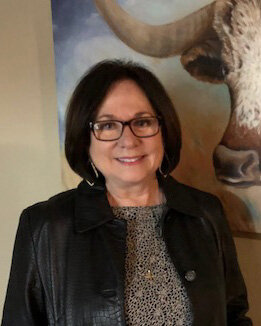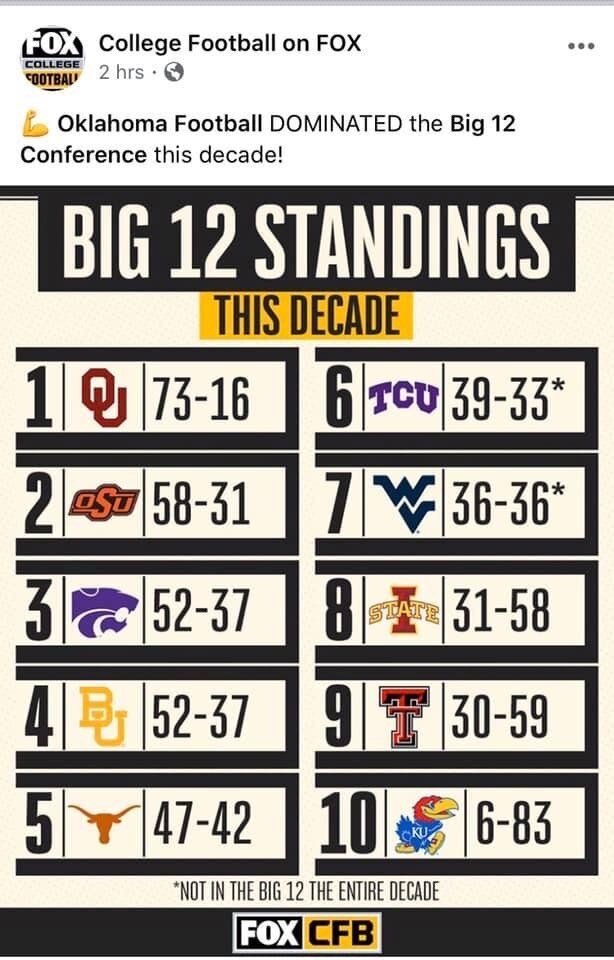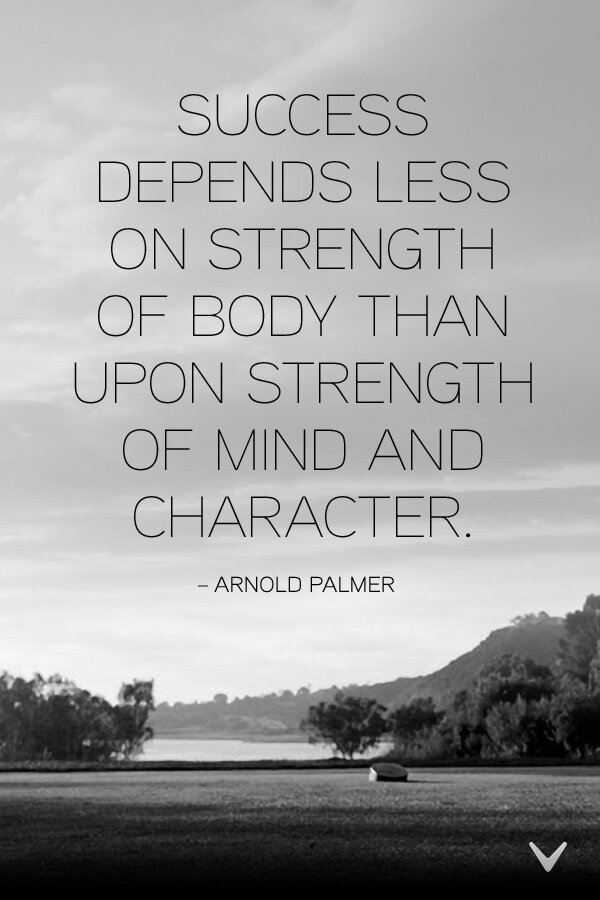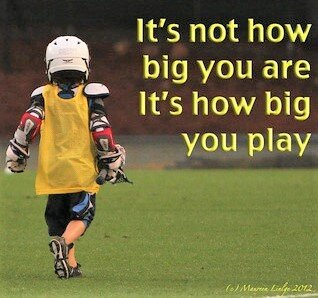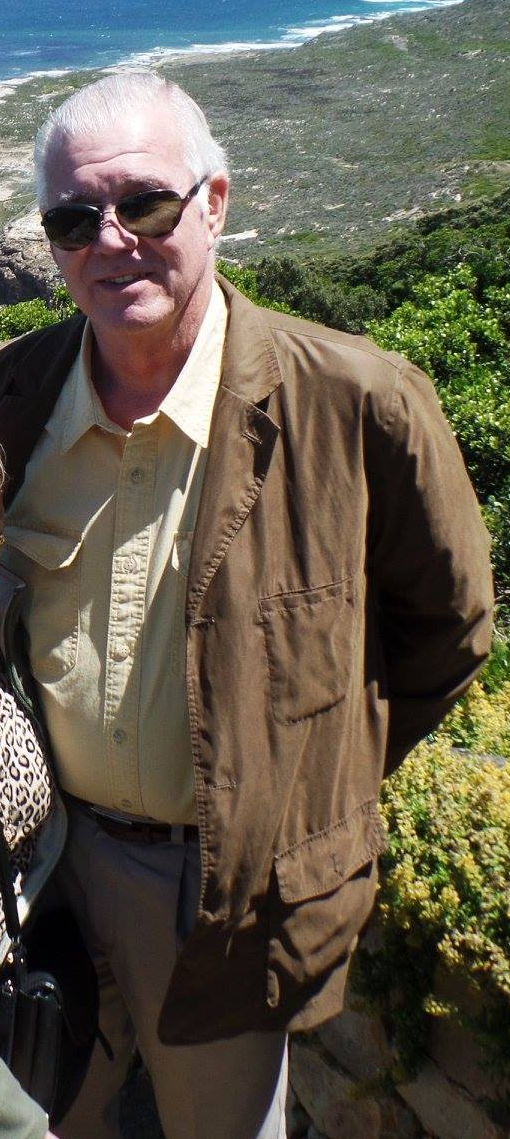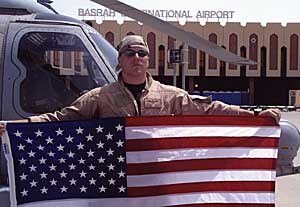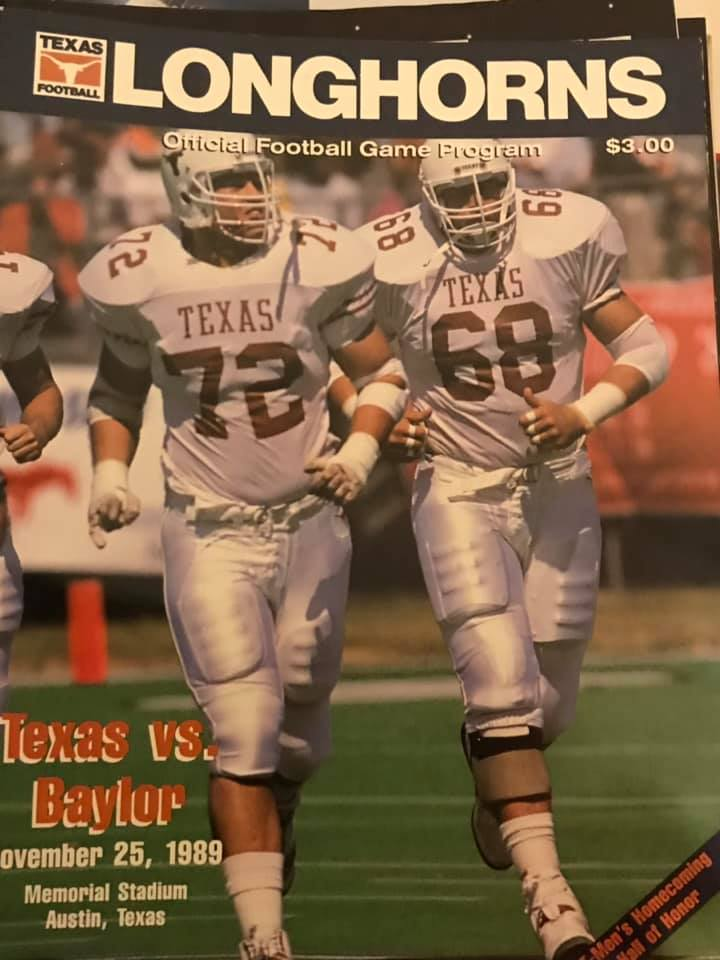12/25/2020
Garbage in garbage out
Computers can not quantify what makes a young boys “motor run”. Coaches HAVE TO do that.
Barbara Wainscott says about her All-American husband, who played for DKR, "Loyd, was a good football student. He studied everything Coach Royal made available to him and was not just a student of the game but a student of every game. He prepared rigorously, and he left it all on the field. When Coach heard that Loyd had passed away, he said: "Loyd's motor never stopped running." That was true. And part of the reason was that Coach knew how to start his motor."
From 2008-2020 Longhorn football failed to recruit players with their "motors running." The Longhorn graphic below against Big 12 opponents proves this point. Part of this is the Coaches fault, but part is an inbred losing culture that is slow to adapt and correct. It is unfortunate that the U.T. Administration in the past decade has been more comfortable firing a coach then replacing a losing culture.
Coach D.X. Bible, the Texas football coach in the late 1930s and early 1940s, and Coach Herman were forced to convert a losing culture into a winning tradition. Bible accomplished this goal, but it took three years with a dismal W-L record of 8 and 20 before the program turned around. In Bibles early years, many fans wanted Bible fired, calling his football program "Ali Bible And The 40 Sieves".
Coach Herman's situation is similar to Coach Bible's with two difference:
#1- with the advent of social media, many Longhorn fans now are more myopic, unforgiving, hostile, and demanding than in 1939.
#2- Under Coach Herman, Longhorn football cultural revolution in the last three years is working- Bibles was not. In three years, Herman transformed Texas into a competitive power with a winning record and three straight bowl victories.
Computers cannot evaluate the Soul of a player.
2009-2018- A Decade to remember, Deliberate, and correct
I have always questioned computer processors' ability to determine what makes high school players "motor run." I am not the only one.
Longhorn Fan -John Pharr says, "It's hard for a computer to measure football savvy in a young player. You have to watch them play, talk to their high school coaches and the kid.
Longhorn fan Bert Hancock says, "that focusing on the star rankings is a prescription for disaster. There can be a four-star player because the player had the fortune of being in a great system..... they had the best of facilities, nutrition, coaching, etc. In contrast, you have a two or three-star guy who comes from a rugged background, didn't start playing football until a couple or so years before, has a school with limited resources, but is hungry, quick, fast, and lean, ......"
Reflection Point
Dan Napier is adamant that the UT Coaching staff before Herman made some terrible computer-generated quarterback recruiting decisions. Dan says, "Texas recruited my dear friend Andre Ware to play DB! Manziel and RGIII were recruited to play other positions other than at QB. That's three(3) Heisman Trophy winners who's positions would have been changed had they come to Texas! Baker Mayfield, Nick Foles, and Drew Brees were in the backyard. Two out of these three are Super Bowl MVPs!" Billy Dale adds that even the 1989 Heisman trophy winner Andre ware considered Texas until the Texas coaching staff said they would use him as a defensive back.
To Dan's point, here are the quarterback recruiting facts after Colt McCoy left, as researched by Bleacherreport.com. The link is below
https://bleacherreport.com/articles/1769270-history-of-texas-longhorns-quarterbacks-post-colt-mccoy
All recruiting statistics presented below are from Rivals.com. This includes recruiting rankings, star ratings, offers made to individual prospects, etc.
2006
Texas' misses from the class of 2006 include Matthew Stafford (a 5-star prospect from Dallas), Greg McElroy (a 3-star from Southlake, Texas), Christian Ponder (a 3-star from Colleyville, Texas) and Andy Dalton (a 3-star from Katy, Texas).
According to Rivals, the Longhorns did tender an offer to Stafford (who went to Georgia) but didn't extend deals to McElroy (Alabama), Ponder (Florida State), or Dalton (TCU).
All five quarterbacks Texas passed on in 2006 went on to play in the NFL.
In 2006 the Longhorns signed Sherrod Harris—a 3-star prospect from Arlington, Texas.—and Jevan Snead, a 4-star from Stephenville, Texas.
Harris waited in the wings for most of his career, playing only a couple of times and accumulating zero stats; he quit the team in August of 2010. Snead wound up transferring to Ole Miss at the end of the 2006 season. After two years as the Rebels starter, he went undrafted in 2010 and never played in the NFL.
2007
In 2007 Texas signed G.J. Kinne, a 3-star from Gilmer, Texas. Kinne transferred to Tulsa in 2008 and started there from 2009 to 2011. He went undrafted in 2012 and is now trying to secure a spot on the Philadelphia Eagles' roster.
The Longhorns missed out on both Ryan Mallett (a 5-star from Texarkana, TexasL) and Nick Foles (a 3-star from Austin) in 2007.
Mallett initially signed with Michigan but landed at Arkansas, while Foles signed with Michigan State and landed at Arizona State.
According to Rivals, the Longhorns did make an offer to Mallett but passed on Foles. Both are active in the NFL.
2008
In what turned out to be a big year for quarterback recruiting in the state of Texas, the Longhorns didn't sign a signal-caller in 2008.
Prospects that Texas missed out on included Andrew Luck (a 4-star from Houston), Robert Griffin III (a 4-star from Copperas Cove, Texas), Darron Thomas (a 4-star from Aldine, Texas), and Nick Florence (a 3-star from Garland, Texas.).
Luck went to Stanford, Griffin and Florence signed with Baylor, and Thomas landed at Oregon. According to Rivals, none of the four received an offer from Texas.
Both Luck and Griffin are starting quarterbacks in the NFL, Thomas just signed with a team from the Champions Pro Indoor Football League, and Florence has retired from the game.
2009
In 2009, Texas signed 5-star prospect Garrett Gilbert out of Lake Travis High School in Austin. After making a notable appearance in relief of an injured McCoy in the 2009 BCS title game against Alabama, Gilbert wound up transferring to SMU in 2011. Gilbert finished his career with the Mustangs in 2013 and was rated by NFL Draft Scout as 40th-best quarterback in the 2014 NFL draft.
The only real name to come out of Texas in 2009—other than Gilbert—was Casey Pachall, a 4-star out of Brownwood, Texas. He attended TCU.
Given that the Longhorns were set on top-gun Gilbert in 2009, it's no surprise that they didn't knock on Pachall's door. That said, it's compelling that NFL Draft Scout has Pachall at No. 14 among quarterbacks available for the 2014 draft.
2010
In 2010, Texas signed 3-star Case McCoy from Graham, Texas, and 4-star Connor Wood from Houston.
McCoy—a senior in 2013—is now serving in a backup role to starting quarterback David Ash. Wood transferred to Colorado in August of 2011 and is the go-to guy for a Buffaloes team off to a surprising 2-0 start.
In another relatively dry year for Lone Star State quarterbacks, the most notable miss for the Longhorns in 2010 was 4-star James Franklin from Corinth, Texas.
According to Rivals, Texas didn't tender an offer to Franklin; a decision based on Missouri's performance was not ill-advised. That said, it would have been interesting to see what Franklin—with tremendous athletic ability—could have done with the talent that would have surrounded him in Austin.
2011
This was the year that Texas picked up 3-star prospect David Ash from Belton, Texas. As a junior in 2013, Ash had to fight to keep the starting job in a fluid situation.
Quarterbacks that the Longhorns passed over for Ash in 2011 include 4-star J.W. Walsh from Denton, Texas, and 3-star Johnny Manziel from Kerrville, Texas. Again, according to Rivals, Texas didn't make either of these guys an offer.
Manziel won the Heisman as a freshman at Texas A&M in 2012, while Walsh was named the starter at Oklahoma State after his Week 1 performance in a win over Mississippi State.
Manziel is an incredibly sore subject for Longhorns fans because he—like Winston—wanted to play for Texas.
According to Trey Scott in a Dallas Morning News article from December of 2012, which quoted Manziel's appearance on the Dan Patrick Show, Manziel stated that Texas recruited him a "little bit" as a defensive back. Manziel said, "I actually called them and expressed an interest to them and let them know just how much I wanted to be a part of that program…They were recruiting me more as a defensive back, something that was fine with me at the time because there were schools that were throwing that out there."
2012 and 2013
In 2012, Texas brought in 4-star Connor Brewer from Scottsdale, Ariz., and in 2013 it was 4-star Tyrone Swoopes from Whitewright, Texas. Brewer—the only guy from outside of Texas since 2006—announced his transfer to Arizona.
The Bottom Line
There are three ways to explain how Texas hasn't managed to produce a star quarterback since McCoy: low evaluation (insufficient computer data), limited scope in the recruiting process, and poor coaching. Either Texas isn't finding the right guys or, instead, it does have enough talent at quarterback, and it's messing up the coaching.
Though the coaching angle is compelling, the hits-versus-misses ratio in recruiting—especially in the state Texas owns—is so high it is impossible to argue that the problem is all coaching. The Winston debacle could stand on its own as a red flag that something was amiss in Texas' recruiting process, but when you add in the lack of an offer to guys like Luck, Mallett, Griffin, and Manziel, the pattern is clear.
Not only does Texas not cast its net far enough into the national recruiting scene, but it is also missing the boat in its state.
Coach Mack Brown
I am a Mack Brown advocate, but statistically, Coach Brown won very few team titles. Before Texas won the national championship in 2005, many fans even accused Coach Brown of, as Chris McComb says, "doing less with more from four and 5-star athletes".
Excluding team titles, Mack Brown was the consummate '"star" catcher- Leading the nation in recruiting NFL quality athletes, compiling a tremendous won-loss record, winning five bowl games in a row, and setting a record for top 10 finishes.
Coach DKR
Unlike Mack Brown, DKR, for many and various reasons, did not deliver as many star athletes to the NFL, but Royal had three national championships titles and 11 SWC championships.
You may say that it is unrealistic to compare recruiting in the '60s to recruiting during the last decade, and on many points, you are correct. Recruiting techniques and technology have changed since the DKR era. Compared to coaches in the 1960's many football coaches in the 21st century no longer have the time to judge talent on a personal level, and that is a problem. In contemporary times reaching for the "stars" by data mining is more important than looking for earthly hidden gems.
Computer data mining discounts the inherent recruiting principle that is the cornerstone of building great teams. Bear Bryant believed, "What matters.... is not the size of the dog in the fight, but the size of the fight in the dog." Bryant says about Leon Fuller, a 152 pounder who will eventually be the Defensive Coordinator under Akers, is "the little man with the big heart." In The Junction Boys by Jim Dent, Bryant says, "didn't mind if a player was a little short in talent or stature if he compensated it with a big heart. Bryant even said, "I can reach a kid who doesn't have any abilities as long as he doesn't know it." Bryant says, "Life's battles don't always go to the stronger or faster man. But sooner or later, the man who wins is the one who thinks he can."
Royal agrees with Coach Bryant. Royal, during his high school years, was told that he was too small to play football, but Royals “motor was running”. As a college coach,Royal knew from personal experience that a young man's attitude wins football games. Royal chose to mine for hidden gems around him instead of grasping for the stars above. Royal understood that athletes who are small and slow, but who think they are big and fast might not be high ranking stars, but they are unselfish players who added synergy to the team.
Longhorn fan James Kegan says Coach Royal could find Diamonds in the rough🤘 recognizing those whose “motor was running“ as a talent 🤘🏾.
Gaylon & Donna Ray Wainscott say, “ Determination, heart, and taking pride in the team will produce champions. Never underestimate the heart of a champion. “
James Cook says, "It seems to me that Coach Royal found good players from small towns. It doesn't seem that kids recruited now below AAAA get much of a shot."
Chal Barnwell and Jay Cormier, both Longhorn football players from the late '60s and early 70's, agree with James Cook.
Chal says many of Royal's great players were from small towns – athletes such as "Bob McKay, Bill Bradley, James Saxton, Jerry Sizemore, Jim Bertelsen, Travis Roach, Ernie Koy, Steve Worster, Leo Brooks, Glen Halsell, and many others.
Jay Cormier says about the 1967 recruiting class "our team came from what I call black and blue leagues in small towns with hard-working parents who expected the best on and off the field from us. Most of us were the first In the family to attend college. “
Royal also gravitated to recruits with dreams. No great activity starts without a dream, and as a young man, Royal dreamed of kicking a ball 90 yards, and running faster than anyone.
Royal's most enduring legacy is building bridges for young Longhorn dreamers to cross. I am a product of his legacy. As a young man with dreams of greatness, Coach Royal built a bridge for me to cross so I could have the chance to fulfill my dreams. In me, he saw a young man who thought he was bigger and faster than he was and nurtured those beliefs. I did not fulfill my goal of greatness as a Longhorn athlete, but I did enjoy contributing and being part of a great team. Regardless of individual accolades, I did cross the bridge Royal built for me and found on the other side new dreams that resulted in fulfillment in different forms. In life, that is all a bridge-builder can do.
Royal was not averse to using computers. Barbara Wainscott says, "Royal's use of computers was unprecedented in the '60s. "This was, after all, The University of Texas, a crown jewel in the royalty of academic excellence. Buried in the belly of the beast that was the ever-expanding University of Texas of the late 60's was a CDC 6600 mainframe computer.
"It was considered the fastest computer until 1969, and most of the first delivered were to laboratories...and to the University of Texas Computer Science and Mathematics Departments." Barbara says "my last Journalism class at UT required that we write a Query letter to a publication explaining an article that we wanted to write and ask if they were interested." I wanted to write about the use of computers in college football. Sports Illustrated had their own writers and never accepted freelance articles. They wanted my article. "
Coach Darrell Royal knew how to make use of this remarkable, cutting edge monster. Barbara says “Every week Loyd Wainscott would bring over a thick stack of papers joined together into one continuous length and bordered on two sides by a continuous line of holes which were used to move the document by sprockets through the printer." "He called them 'the tendencies.' The stack, sometimes as much as three inches thick, was a readout of the tendencies of the opponent to run certain plays at certain times. So every week the computer told Royal what plays the upcoming team tended to run on first and ten, second and eight, second and two and so on.”
Royal intuitively knew computer data could help him win close games, but he never dreamed of recruiting a player based on a print-out. Royal spent time evaluating potential recruits based, not only on talent, but subjective attributes such as character, spirit, and heart.
Like Royal, Coach Snyder was a consummate recruiter of team players, not individual players. In a team sport, football requires 22 bonded, passionate players working in sync successfully executing the smallest details to win. Coach Snyder says, "If you do pay attention to detail and the 'little things' are important to you, you make them important to people." Coach Snyder understood recruiting future football leaders is as much an art form as a science. Recruiting requires conceptual thinking, intuition, and technical skills, not just computer extracted data.
The future of Texas Longhorn football will experience ebb and flows, ugly and great games, but like Nathan Kaspar and Ken Hackemack , I believe that the winning trend line will continue under Herman.
The Good News
In the first two decades of the 21st century, winning football teams such as Alabama, Oklahoma, Clemson, and Ohio State have correctly read computer data print-outs to select the right recruits while mastering the art of analyzing recruits base on subjective qualities such as heart, spirit, work ethic and .....
Former Texas Longhorn football player Nathan Kaspar says “The thing that most fans don't realize is that star rankings expire the day a kid walks on to campus. This may have been year 3 (2019) of Coach Herman's tenure, but the seniors (what few there were) were all Charlie Strong recruits, and they came in at the end of his failing reign. Our most experienced players aren't very highly rated, and we don't have many experienced players.”
When you look at Iowa State's roster, they have Eight 5th year senior starters. We didn't have a single 5th year senior in our entire two-deep. A 3 star OL who has been working and developing for five years is going to be 23 or 24 years old. He's going to beat your 19-20-year-old 4-star players.
Texas had plenty of fight in 2019 ; it wasn't a culture or effort issue. We are upgrading the coaching staff and will continue to develop.
Ken Hackemack discuss’s the critical problem that transformed a 2019 Longhorn team that almost beat LSU into an average team.
Some fans will call Ken’s reason an excuse, but it is not. It is a fact that Injuries to starters hurt a teams performance and forces the coaching staff to adjust their offense and defense scheme to the talent on the field. The OC and DC in 2019 did a poor job at this, and each has been replaced.
Ken Hackemack #68 says that the 2019 team could have lived up to expectations, BUT injuries to key players hurt the team performance. Ken says, "I frown upon the coaching staff's inability to keep players healthy. Too many starters getting hurt too often. I'm tired of seeing freshmen and sophomores playing the majority of the spots during November due to injuries. There should be no reason a backup quarterback has to be our primary running back down the stretch. Technology has done wonders, both good and bad, for football, and unfortunately, we still have not found that balance to keep our athletes healthy and get back to our winning ways.
Billy Dale agrees. Replacing the OC and DC won't help if the current strength and conditioning coaches in the 2020 offseason don't change the exercise programs to mitigate the type of injuries that occurred in 2019.

